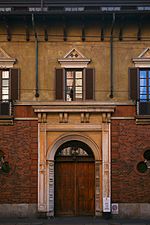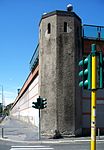San Vittore al Corpo, Milan

The church and monastery of San Vittore al Corpo were an ancient monastery of the Olivetan order built in the early 16th century. The site was once a fourth century Roman imperial mausoleum of Maximian, that may also have held the burials of the emperors Gratian and Valentinian II, though they were more likely buried in another mausoleum, now the Chapel of Saint Aquilinus in the Basilica of Saint Lawrence. The basilica was enlarged in the 8th century to house the relics of the saints Vittore and Satiro. A Benedictine monastery soon was attached to the church. In 1507, the monastery was transferred to the Olivetans, who began a major reconstruction. Reconstruction of the church was begun in 1533 by Vincenzo Seregni, and completed in 1568 by Pellegrino Tibaldi. The façade remains incomplete. The dome was frescoed in 1617 by Guglielmo Caccia (called "il Moncalvo"). In the chapel of St Anthony is a 1619 canvas by Daniele Crespi (Death of St Paul the hermit). In the transept on the left, is an early 17th-century cycle of canvases of the Stories of San Benedetto, by Ambrogio Figino while the right transept has three altarpieces by Camillo Procaccini. Other chapels have paintings by Pompeo Batoni and Giovanni Battista Discepoli. During the Napoleonic wars, the site became a military hospital, and afterwards became barracks. It suffered damage during the bombardments of 1943. The monastery now houses a museum of science, the Museo Nazionale Scienza e Tecnologia Leonardo da Vinci.
Excerpt from the Wikipedia article San Vittore al Corpo, Milan (License: CC BY-SA 3.0, Authors, Images).San Vittore al Corpo, Milan
Via degli Olivetani, Milan Municipio 1
Geographical coordinates (GPS) Address Phone number Website External links Nearby Places Show on map
Geographical coordinates (GPS)
| Latitude | Longitude |
|---|---|
| N 45.462693 ° | E 9.170084 ° |
Address
Basilica di San Vittore al Corpo
Via degli Olivetani
20123 Milan, Municipio 1
Lombardy, Italy
Open on Google Maps











